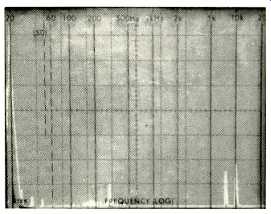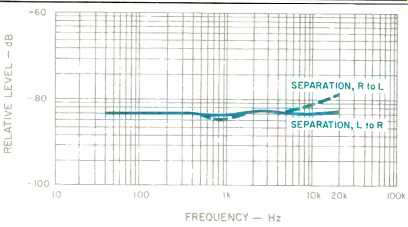
Manufacturer's Specifications
Frequency Response: 20 Hz to 20 kHz, ±0.3 dB.
Dynamic Range: 110 dB.
S/N Ratio: 103 dB unweighted, 110.:3 dB A-weighted.
THD: 0.004% at 1 kHz.
IM Distortion: 0.0044% at 0 dB.
Channel Separation: 103 dB at 1 kHz.
Line Output Level: 2.0 V rms.
Number of Programmable Se lections: 20.
Power Consumption: 30 watts.
Dimensions: 16 9/16 in. W x 3 9/16 in. H x 11 13/16 in. D (42 cm x 9 cm x 30 cm).
Weight: 16.5 lbs. (7.5 kg).
Price: $1,195.
Company Address: 2911 Oceanside Rd., Oceanside, N.Y. 11572.
The popularization of Compact Discs has generated a whole new secondary industry. No, I'm not talking about the companies that produce CD cleaners, scratch removers, disc stabilizers, mounting feet and the like, though surely the makers of these "peripherals" have benefited from the digital revolution too. I'm referring to the increasing number of companies which modify Philips or Philips-made Magnavox players by replacing the audio stages, output filters, and perhaps Philips' permanently wired output cables. In the process, the price of these audiophile versions in creases, from a few hundred dollars to over $1,000. This $1,195 unit from Discrete Technology (Distech), for example, is based on the Magnavox FD2040, whose suggested retail price is $300.
The Magnavox FD2040 was and is a fine-sounding CD player, employing as it does four-times oversampling and digital filtering to begin with. It can be programmed for random access of up to 20 CD tracks. No remote control is supplied with this Magnavox model nor with its Distech counterpart. As far as I can tell, what Distech has done is to add some heavy internal output cables and substitute their own line output amplifier and analog output filter. They have also added a variable output control for one of the two pairs of output jacks; this enables the user to connect the unit directly to a power amplifier, thereby eliminating one component in the signal path. Distech tells us that they have also modified the power supply to lower its impedance, and have split up the circuitry into a quasi dual-mono configuration, for increased separation. Distech has included a two-page addendum to the owner's manual, one page of which lists technical specifications of the revised unit.
Control Layout
A power "On/Off" button and an "Open/Close" button flank the slide-out disc drawer at the left of the LSI Mk. II's front panel. The multi-purpose display to the right of the drawer indicates the number of tracks and total playing time of a disc shortly after it's been inserted. During play, indications of track number and elapsed playing time of that track are shown. During programming, the display shows track numbers to be stored and those already stored. "Error," "Repeat," and "Pause" LEDs are also located in this area.
A large, multi-function control pad to the right of the display area is used for starting play, returning to the beginning of a track, fast searching in either direction or interrupting play ("Pause"). Different functions are activated by touching the appropriate edge of this rocker pad. A "Stop" button is located beneath the rocker pad; to this button's left, below the display area, are a "Repeat" button, a head phone jack, a button labeled "Previous" (for returning to a previous track during play or during programming), a "Pro gram" button (for storing tracks and producing a display of the program stored), and a button marked "Next" (for moving on to the next track during play or programming).
On the rear panel, Distech has installed two pairs of output jacks and an output level control in place of Philips' permanently mounted audio cables. Separate output cables, heavier than the originals, are supplied by Distech.
These cables are marked with arrows which should point away from the player, Distech says, as if to guide the signal in the proper direction. The cables are also color-coded with wraps of tape to match similar bits of tape affixed near the output jacks. In my sample, however, the colors were re versed, causing the channels to be reversed, left for right, when Distech's color code was followed. I corrected this when testing, and made sure the arrows on the supplied cables pointed in the recommended direction.
Measurements

Fig. 1--Frequency response, left (top) and right channels.

Fig. 2--S/N analysis, both unweighted (A) and A-weighted (B).

Fig. 3--THD vs. frequency at three signal levels.

Fig. 4--Spectrum analysis of 20-kHz test signal. Note the ultrasonic component
at 24 kHz, to the right of the desired signal.

Fig. 5--Spectrum analysis of 1-kHz signal (large spike at extreme left).
While the main spurious components are at 40 to 45 kHz (far right), at least one is in the audible band at about 17 or 18 kHz. (See text.) Sweep is linear from 0 Hz to 50 kHz.
Frequency response of the LSI Mk. II was flat within- 0.2 dB from 20 Hz to 20 kHz. Response curves, shown in Fig. 1, display a bit of a wobble near the high end, though the wobbles are less than a couple of tenths of a dB in amplitude. These are probably attributable to the "improved" analog output filters which Distech says are incorporated in the unit. I don't seem to recall a similar undulation in the response curve of the original Magnavox unit.
Signal-to-noise readings did not measure up to the published claims nor, for that matter, to the S/N values achieved by the unaltered Magnavox (or Philips) unit. As shown in Figs. 2A and 2B, unweighted S/N for my sample measured 89.0 dB and A-weighted S/N was 95.2 dB. Neither figure is anything to crow about compared to the readings I have been getting lately for third- and fourth-generation CD players. Linearity was accurate to within 0.1 dB down to a-60 dB signal level, but was off by more than 3.0 dB at a-80 dB level. Output level for a maximum (0-dB) recorded signal was 2.09 V, and there was no difference in output level between channels.
Harmonic distortion measured around 0.005% at mid-frequencies for a 0-dB recorded signal level. Figure 3 shows THD as a function of frequency for this and lower levels. The dotted lines above 10 kHz or so represent "beats" or spurious output components not harmonically related to the re corded test tones. Figure 4 shows what happens in the presence of a 20-kHz tone reproduced by this player. An ultrasonic component at around 24 kHz shows up, and it is only about 50 dB below the desired 20-kHz output. Naturally the distortion analyzer sees this as a distortion component even though it would be inaudible to a human listener.
Of a somewhat more serious nature are the spurious components generated when a 1-kHz signal is reproduced from a test disc at the 0-dB level, as shown in the spectrum analysis photo of Fig. 5. The tall spike at the extreme left (almost off-screen) is the desired 1-kHz signal. Additional signals, at least one of which is in the audible region at around 17 or 18 kHz, appear farther to the right, with other spurious components seen at around 40 to 45 kHz. I have not previously encountered such spurious components with other CD players when reproducing a low-frequency tone such as this. I car only conclude that perhaps the newly installed line-output preamplifier stage is causing the difficulty and that we are dealing here with an overload problem rather than with a "digitally" generated artifact. This conclusion is substantiated by the fact that the spurious products disappeared entirely at lower recorded levels.
Separation between channels was excellent, ranging from about 84 dB to around 79 dB at high frequencies. If nothing else, the separate output-stage cables (both the internally wired ones and those supplied for external connection to an amplifier) prevent any capacitive coupling of signals be tween channels. Separation as a function of frequency is shown in Fig. 6.
Dynamic range of the Distech LSI Mk. II, measured in accordance with the new EIAJ method, was 113 dB, 3 dB higher than claimed. SMPTE-IM distortion was 0.003% at 0 dB recorded level and 0.022% at a- 20 dB level. Using 19 and 20-kHz test tones of equal amplitude, CCIF (twin-tone) IM measured a very low 0.0018% at a 0-dB recorded level, increasing to 0.008% at a -10 dB recorded level.
Figure 7, a 'scope photo of a reproduced 1-kHz square wave at a 0-dB recorded level, confirms the fact that digital filtering is used in this player, as does Fig. 8, a 'scope photo of a reproduced unit-pulse signal. Figure 9 confirms the fact that this player employs dual D/A converters; the 20-kHz signals at the left- and right-channel outputs are exactly in phase. (I vertically offset the two signal traces in the photo so you could see that two signals were present.) The first and second generation of Magnavox players, which I tested more than two years ago, were among the few players of that era that could successfully play through the simulated defects on my special Philips test disc. Since Distech bases their LSI Mk. II on the second-generation Magnavox FD2040, it was not surprising to find that this player also made its way through the simulated scratch, dust particles, and fingerprint smudge of the test disc with out so much as a momentary glitch. As for speed of access, the unit could go from one track to an adjacent track in about 2 S, and from an innermost track to an outer track in about 6 S. That's a bit slower than some of the newest players using linear motors, but hardly cause for upset.

Fig. 6--Separation vs. frequency.

Fig. 7--Reproduction of a 1-kHz square wave.

Fig. 8--Unit-pulse test.
Fig. 9--Interchannel phase response using 20-kHz test tone shows that separate D/A converters are used in each channel. The match was so exact that one channel was vertically dis placed to prevent total overlap.
Use and Listening Tests
The Distech LSI Mk. II sounded fine to me, but then, so did the player upon which it is based. I wish that I had had the unmodified version of the FD2040 against which to compare the Distech unit in a double-blind test. Since I did not, the best I could do was try to honestly judge the sound quality of this player against that of other top-of-the-line units which were in my lab. I also compared the sound quality with that achieved by lower priced units I had on hand, including a couple of portables selling for around $300.
There was no question in my mind that the LSI Mk. II sounded better than the portables. However, I cannot hon estly say that it sounded any better than the high-end samples. Incidentally, as the higher priced units all had variable output-level controls, I followed Distech's advice and connected these players directly to a power amplifier when making my comparisons, as I had done with the Distech. After several hours of listening, I concluded that the LSI Mk. II sounds very good indeed, but no better than several other of my favorite CD players, some of which sell for considerably less and include remote controls.
-Leonard Feldman
(Adapted from Audio magazine, Nov. 1986)
Also see:
Denon DCD-1500 Compact Disc Player (Jun. 1986)
Mod Squad Prism Compact Disc Player (Auricle, Aug. 1988)
Mission PCM-7000 Compact Disc Player (Aug. 1987)
= = = =